
Agile Methodology, Customer Experience, Outsourced Engineering Team, Product Development, Project Management, Successful Outsourcing
Of course, the first question for anyone looking at this is – what is the difference? Let’s start by saying that we’re not speaking specifically about “product engineering” – although it plays a part in this discussion. We’re actually looking at software development teams broadly, how they work and what they can (and can’t) do for your development efforts.
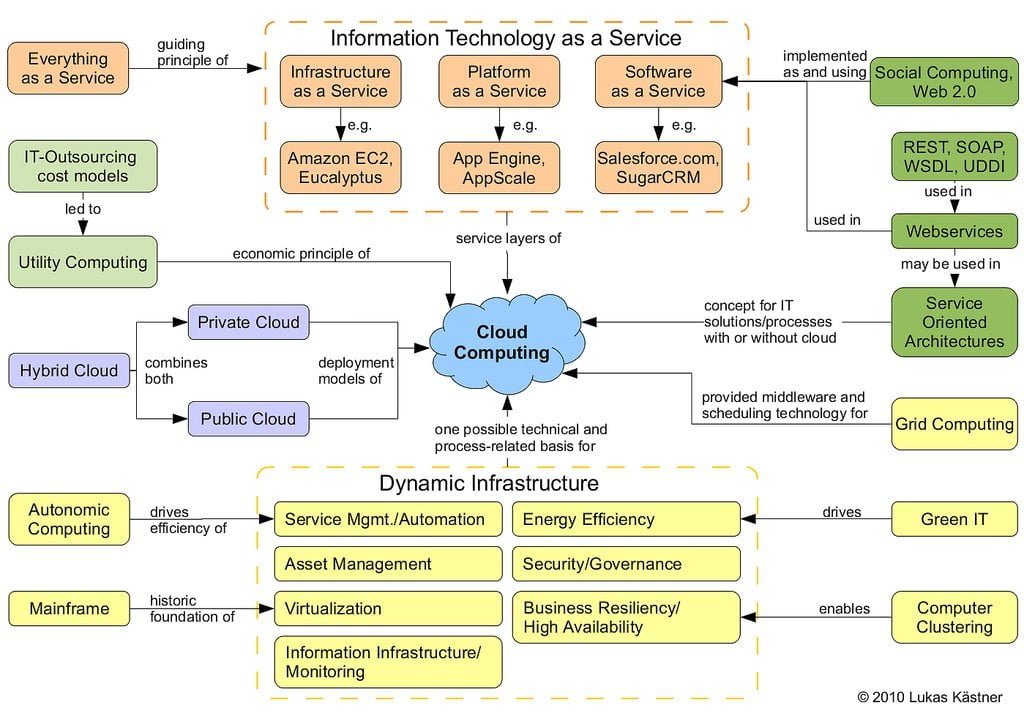
Today’s IT environments can be complicated beasts – with unique mixes of internal and remote API’s, web services, service-based components, virtualized infrastructure, and various open source, proprietary and custom applications. Orchestrating this architecture to provide the internal and external business services for an organization is an increasingly critical operational concern. Depending on the size and complexity of the environment, it is likely to be managed by one or more skilled engineers who are focused on the security, standardization, automation, scalability, availability and reliability of IT systems.
Traditionally, software development teams have been separated from this complexity to some degree by internal standards for application architecture and operation developed by IT. But, as the maturity of IT environments has progressed and agile has become the standard of the tech industry, software development teams are gradually being integrated into combined engineering and engineering teams under DevOps implementations. At this point, there are many different levels of integration between IT engineering and software development teams and if you are considering outsourcing a project – knowing what you are asking for is an important part of your research and decision process.
So, let’s set up a scenario: You are about to embark on a custom software development project. For the sake of this discussion, let’s assume the application to be developed is strategic and tied to your business model. With so many applications and systems available on the market, if it wasn’t – you would probably just adapt an off-the-shelf application for your purpose. You have a charter and description of the business problems your custom application needs to address, a general budget and executive support. The decision has been made to outsource this project rather than do it in-house.
With that in mind, let’s insert some different conditions that could make a significant difference in your needs for an outsourced team:
- New, but fully-backed venture with basic organizational structure but with no IT engineering beyond office systems automation and help desk.
- Existing IT team with legacy experience but little experience with modern infrastructure or IT operation patterns. No dedicated development team or significant custom applications.
- Traditional operations, IT and software development but siloed – not integrated other than by operational standards.
- An enterprise-level organization with a fully-integrated IT operations and development team in a DevOps style implementation with a significant portfolio of custom applications that are under continuous development and/or maintenance.
- A new venture of an existing entity that is expected to operate as a free-standing organization based to a large extent on the services provided by the new application(s) developed during the project.
There are other complexities we could imagine, but for the most part, they can be addressed as variations of these five scenarios and the basic conditions we set up for this discussion.
1. The New, Mostly Naked, Venture
As a new and growing company, there is always (or there should be) pressure to be efficient and do things right from the beginning. If you have a technical leader in your team and/or a significant part of your operation is based on leveraging software applications to provide your services, there is a natural tension – should you focus on your customers, your value proposition and lead your software development at the product level (leaving the actual development to an outsourcing partner), or should you build and control everything in-house? We’ve covered this question before and it is a significant decision – but now, we’re considering a little deeper level of thought. If you are considering an application that will actually support all or a significant part of the services you offer and your revenue – the proper operation and maintenance of that application is a strategic decision.
Your application must be:
- Planned with a set of operational standards in mind.
- Scalable, so it can grow along with your business without significant rewrites and basic changes in architecture.
- Logically broken into maintainable and extensible modules so it can be enhanced and the value of individual services can increase as they find their place in your portfolio.
- Reliable across upgrades, changing loads, and new features through the full product lifecycle.
- Economical to operate and maintain based on a solid architecture and the ability to leverage automation across all levels of development, deployment, and maintenance.
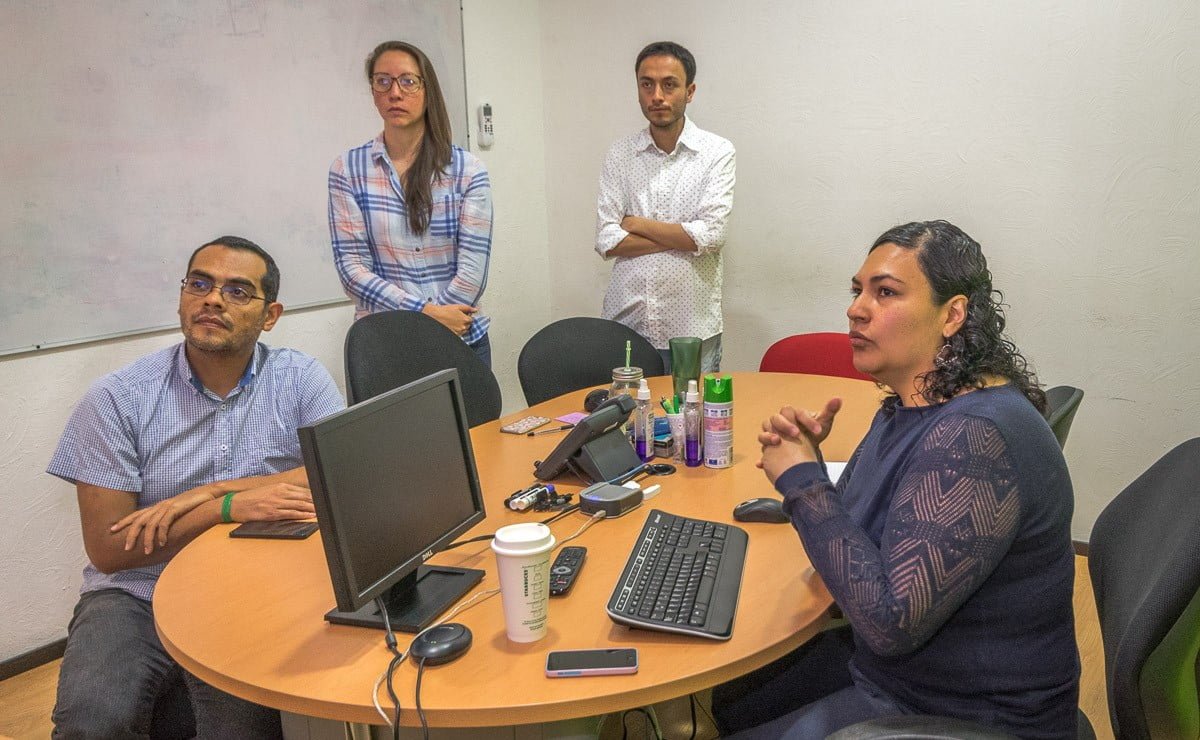
Photoshoot at Cluster 8/1/16
If you are a new venture and you want to spend your time focusing on your customer, the value of your services, and managing feature-fit, you shouldn’t expect an outsourced development team to simply take on these issues from day one. They may deliver a wonderful application that provides everything you need, except the five points above. Although your customers will be happy, you have just purchased a load of technical debt. Like any loan, it will come due at some point and the longer you wait to deal with these shortcomings – the more expensive they will be to retire.
So as an entrepreneur with enough problems on your plate, you have a choice (remember – our scenario is that you’re going to outsource this project):
- Dig in and hire a really competent engineering team that has real world experience in larger operations and understands where you are going. It is going to be expensive, time-consuming and at times – frustrating. You will have more expertise sitting around than you need in the early days, but it is an investment you need to make in lieu of the cost of redoing much of your early work when all your predictions come true. You don’t want to have to operate your business while changing the undercarriage as it speeds down the road. Once you have your engineering team and they understand your business model and where you are headed, they can manage your outsourced development team – but with both sides being new to you it is likely to be a fairly inefficient match in the beginning. Expect six to nine months to hire, train, and begin your project and another period of time integrating your outsourced team (which you also have to select) and your in-house engineering to the point where the combined team can be productive.
- Find an outsourcing partner that can provide the engineering skills as a part of the team they provide. If you find the right vendor, the team should be scalable with the resources you need, when you need them. The application should be designed with the five points above in mind from the start. If the vendor operates as a partner with your organization, doing that part of the development and operation successfully is part of their value proposition to you. If the outsourced team has broad experience (as they should) they will bring to the table a range of solutions you may not find otherwise. They have worked in the market and delivered solutions in many different situations. Finding the right vendor will not be as quick as it might be if you were only looking for an outsourced development team (there are many pretenders in the field), but in the end, you should be able to get your project running faster, with better efficiency, lower cost, and risk.
The choice is yours and (of course) there are other factors you may have to consider in your situation – but at a high level, if cost, time-to-market, and lowering distractions from your emerging business are concerning, an outsourced engineering and development team would seem to be a strong option.
2. Existing IT Team, No Internal Software Development Team & Little or No Current Experience with Custom Apps and Modern Infrastructure
At first, this would seem to be a simple match for an outsourced development team – and in some cases it may be. But, the lack of current experience with custom application development and modern infrastructure in this situation should be concerning. Companies in this position tend to be service-based, SMB/E organizations with established client bases, regional strength in their market and a strong, competitive need to grow. As we pointed out at the beginning, we are assuming there is a budget for this project and the company is committed to outsourcing but – they have an existing market and they can’t afford to burn their existing customers while they transition to a new or expanded level of services. Because of that limitation, even without considering the eventual operation and maintenance of the new application once it is released, an organization in this position can’t afford to overburden their existing staff with development of a mission-critical, custom application and the operational planning needed while they continue to serve and maintain their existing services. The staff must be involved in the changes but only to the extent that they need to be to be able to take a role as things move forward.
Again, we come down to some choices:
Hire one or two technical leads/product and project managers who will take the position of planning the new application, its architecture, and operational requirements while managing the outsourced development team. They will need to be much more experienced than the existing IT team so there will be some initial friction and it will (again) take time, be costly and frustrating. It will take time to get them up to speed and integrated into the team before an outsourced development team can be selected and put to work. The reason to use only one or two resources, in this case, is to hold down costs, but doing so will only make each resource more critical and (probably) more expensive.
- Hire outside consultants to develop the operational architecture, requirements and train your internal team. Since the internal team is unlikely to be large or have the skills necessary, there will still be a need to hire additional internal resources, but it can be delayed to some extent. The downside of this strategy is that when experienced staff is added eventually, they may or may not agree with the direction put in place by the consultants and there may be a period of realignment and unexpected technical debt. Also, the use of external consultants to manage all or part of the work done by the outsourced development team can create an “arms length” relationship with the development team that can make it difficult to have the level of collaboration and trust you need to avoid communication problems, especially with agile development.
- Find an outsourcing partner that can provide the engineering talent as a part them team they provide. If you find the right vendor, the team should be scalable with the resources you need, when you need them. If the outsourced team has broad experience (as they should) they will bring to the table a range of solutions you may not find otherwise. They have worked in the market and delivered solutions in many different situations. If you want to transition the outsourced team out at some point, you will still need to hire additional staff for operations and maintenance of your new applications, but you should be able to have them work in parallel with your outsourced team during the transition and lower the burden significantly.
Any of the three options could be successful but if you find the right outsourcing vendor, it would be a faster, less costly and less risky route to get your project going. But, of course, it depends on finding an outsourcing vendor with the option to include engineering skills in their team and to have a flexible approach to providing the team you need.
3. Siloed Operations, IT & Software Development Teams
This scenario lends itself to slightly larger and more technically-based operations than we discussed in the second scenario. This is the type of organization we expect to find in an established ISV with a strong client list in a specific vertical. Their operations are usually as they have been for a decade or more. Their IT staff is established and has a strong operational base. Their software development team is well-versed in their existing applications, the technologies they use and the customer base they work with. If they didn’t have to step out of that box to build this new application, we can easily assume they wouldn’t need to outsource and their engineering is just fine for what they are doing today.
 But that is the rub. We’re examining a scenario where they need to extend themselves into new technologies and possibly change their operations significantly. And because we’re assuming their teams are informal, separate silos – we’re also assuming they know about the higher efficiencies they could achieve if they began to shift to a DevOps methodology but – again, like our second scenario, they have existing customers and products/services in the field to maintain and support. Like most companies in this situation, their backlog of feature requests for their existing software is just what they can handle at the moment. Adding another layer of work would just mean something would have to give. An outsourced development team, in this case, makes sense and this organization is likely to have customer-facing product development well-in-hand. But, what they don’t have is a scalable organization to match the importance of the project and a broad understanding of new technologies and architectures they need to consider to streamline their organization.
But that is the rub. We’re examining a scenario where they need to extend themselves into new technologies and possibly change their operations significantly. And because we’re assuming their teams are informal, separate silos – we’re also assuming they know about the higher efficiencies they could achieve if they began to shift to a DevOps methodology but – again, like our second scenario, they have existing customers and products/services in the field to maintain and support. Like most companies in this situation, their backlog of feature requests for their existing software is just what they can handle at the moment. Adding another layer of work would just mean something would have to give. An outsourced development team, in this case, makes sense and this organization is likely to have customer-facing product development well-in-hand. But, what they don’t have is a scalable organization to match the importance of the project and a broad understanding of new technologies and architectures they need to consider to streamline their organization.
So, in this case, an outsourcing vendor who can bring in engineering experience as a part of their team skill and experience, a flexible, scalable team makeup and willingness to work in a partner role to help their existing team rethink and realign their operations could be a real asset. It is risky to try to do both at once with the same team, but if both teams have regular work to do and can collaborate to adapt operations over time it can be an opportunity that would be nearly impossible any other way. Again, the critical step is to have the skilled resources available as an integrated part of the team who can lead the effort to plan architecture and operations before development gets underway and you find that serious adjustment is needed. There are risks in this scenario, certainly, but there is also an upside to making changes in parallel with everyone onboard the organizational development and change initiative.
4. Mature Enterprise with Integrated DevOps style IT and Software Development
Again, we’ve moved the situation up the scale a bit but we’re still committed to outsourcing and we’re still considering what type of a team we need. In this case, the internal team has an implementation of DevOps and even if it is not complete, it is moving forward with staff support and commitment. Like scenarios two and three, our existing team has a number of custom applications in production and knows what it is doing when it comes to operations and development. We can assume they are fully engaged and the time allotted to this project is short, or they would simply hire as needed and do the project internally.
Since this organization has a DevOps implementation, there is already an assumption that new development resources will have experience in both development and systems architecture for continuous development and maintenance. Bringing on a team that doesn’t have that type of cross-functional experience and mindset would be a serious problem. They simply wouldn’t be able to hold up their end. In this case, if the project is to be outsourced, the incoming team must be able to handle both engineering and agile software development if they are going to hold up their end and integrate with the larger team successfully.
5. Spin Out/Off Venture with Software-Based Service
You might think this scenario would be a lot like the first, but spin-out ventures tend to be better positioned and planned simply because they usually come from organizations with a strong market position and goals that are carefully evaluated before the venture is started. In most cases, staff members come from the “mother ship” with a background in product development and deep understanding of the market they are going into. But, because the loss of technical resources inside the home organization could seriously impact production there for a prolonged period, they rarely pull out more than a few senior IT resources. With that in mind, their team is usually fully aware of current technologies and methodologies, even when they may come from an organization that culturally has not be able to move to them as quickly as they might wish.
A spin-out gives this core team an opportunity to move in fresh directions with less organizational baggage and legacy overhead. So, in some ways, they may look like scenario two with little IT in the beginning – but the big difference is they have experience in the product development side of custom software and how supporting systems can be orchestrated. They are better positioned to evaluate partners and decide on the roles they want in-house versus outsourced. Since we said at the beginning that all scenarios would be based on a decision to outsource – the question is still, “Do we just need an outsourced software development team or do we also need an integrated engineering component?”
The decision comes down to how much of the burden the mother organization wants to continue to shoulder and how expensive the “charge-backs” would be if they did. Leaders of spin-outs usually have strong stock incentives to keep costs in line and move relatively quickly to prove their direction is worthy of the risk. If using existing services inside their home company would create complications, slow product development, and increase costs – they will think twice about that direction. Since we have specified that they have already decided to outsource this project, we can assume they are not looking to spend any time taking on problems that do not get their services and products into the market. But that said, we know the IT resources in the venture are limited and if they want to go to a modern continuous release methodology so they can incrementally improve and tune their applications, they will need to have flexible, integrated teams of engineers and developers from the beginning so that their applications are architecturally and operationally sound from the beginning.
Bottom Line
The bottom line here is that software development is shifting away from internally-focused product development, siloed enterprise teams and monolithic applications to incremental release patterns, agile organizations, and customer-focused lean product development. Not everyone is there now. There are many different ways to implement change. But, all of these organizations have chosen to take on custom application development for a strategic initiative, the opportunity now is to do it better with an eye toward the future of their organization. This is just one small part of the change they seek, but it is an important one to consider. So, yes – an outsourced team that brings a range of engineering skills and experience along with their development background can be a big advantage for any of these situations, with a vendor who will operate as a partner in the organization.
Scio provides nearshore, outsourced software development and flexible teams with a range of software development and engineering skills based on our experience in many verticals and situations. Our teams can have flexible roles and their bias is toward agile methodologies broadly. If you have a project in mind, please contact us to discuss how our unique blend of skills and experience can benefit your organization. We would be happy to take the time to listen and provide insight into how we could partner for success.
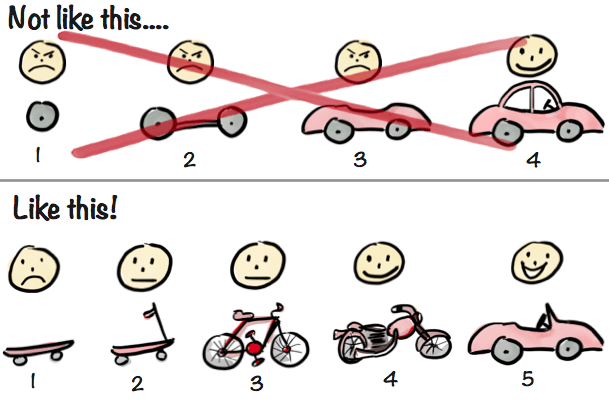
Agile Methodology, Customer Experience, Nearshore, Product Development, Project Management, Successful Outsourcing
Lean Product Development (or Design), LPD, is gradually becoming a standard methodology in software development in much the same way that agile, scrum and lean have become industry standards. But, as is the case with other «standards» – many people say they have strong implementations, but if your product development team practices LPD principles, you might have trouble trying to integrate their approach. That problem can be troubling if you’ve invested in a rigorous, repeatable process for developing and releasing new software products and then find it difficult to find outsourcing services who understand your goals, your process and can work alongside your team seamlessly.
If you have software applications as a part of your services portfolio or directly to clients and use LPD methodologies, it is important to fully integrate your development team. But, if you are using an outsourcing service, what should you expect? How important is it to integrate your outsourced team?
A Little Level-Setting
In strict thinking, although the term «LPD» is used interchangeably for design and development, there are some differences in focus between the two in implementation. Both are based on Lean, the principles that started with Toyota Manufacturing and have evolved to embrace a process of finding solutions to customer problems that emphasizes iteration, reducing waste, and lowering risk. Broadly, both are informed by the Lean Startup Methodology, but because LPD has been adopted by many large organizations for the development of service and product lines, lessons from Lean Startup are brought down to the product level, rather than at a business model level as they are for startups. And, because we are specifically interested in services, software and software development, rather than manufacturing and the development of physical products, we can include the fact that all LPD implementations favor the use of agile, scrum and kanban as development methodologies.

As you might guess from the use of the word design, Lean Product Design implementations are focused on the design of the product, the user interface (UI) in software development terms and how the user interacts with the application. A process flow for a design implementation includes a growing system of sketches of screens (or modules), wireframes and design standards that evolve and become more specific as software development progresses through iterations.
Lean Product Development implementations tend to focus on the features required to satisfy user needs and product goals. So, while both implementations will use agile user story techniques, design-based implementations will be placed more in the context of the UI and user experience. Development implementations will focus more on groups of features and user goals. In practice, the differences between the two are relatively small and depend more on the full project team and their process than anything. A development team with clients that tend to be more visual, literal and unsure of needs may find it easier to be design-focused. A team with clients working on a business process and users with strong, informed opinions may find it easier to be more development-focused. And certainly, there are many blends of the two ways of thinking.
So, What Does This Mean?
There are many software applications that embody process and principles from a software product management point of view. How will they work for you if you decide to use an outsourced software development partner to help bring your application to market? Is one or the other better for software applications or integrating with software development teams? Are there methodologies or points to emphasize with potential partners as you discuss how their product development approach and experience?
From a high level, if your potential vendor has good product development experience and understands the product development cycle fully, the software you use for product management and the implementation of agile they use within their software development process shouldn’t matter a great deal – because they should be able to be flexible and do what is necessary to integrate the teams. If they are using something out of a book or a seminar that they have actually practiced a few times with a client – and that client wasn’t themselves fully committed to formal product management – it will be a distracting challenge for both teams to work through a methodology implementation while developing your application.
5 Questions for Your Potential Partner
Let’s start with a few questions to discuss. And a word about interviews: Don’t ask yes or no questions when you are investigating how a vendor operates and works with clients. Instead, ask open-ended questions that should be answered with more than a few words (if they actually have experience and formal services around the area they are discussing). If you don’t get what you feel is a strong answer, again, ask some open-ended questions that go down a level in detail.
1. Tell me about how you use agile in projects with clients practicing Lean Product Development?
The question here is not «do you use agile?» You need to know how agile informs their work with companies practicing LPD and what value they believe their implementation brings their customers. They should also include their practices within agile, such as scrum, extreme programming (XP), or kanban. If they don’t go into this level, ask another open-ended question for more detail.
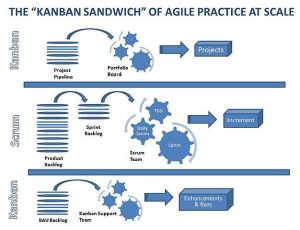
One of the many implementations that large organizations have used.
In most cases, scrum will be the task management and basic development guideline, but it may be extended by XP practices. Some teams will be familiar with kanban and some will mention that they might start with scrum and transition to kanban if the project uses a DevOps implementation aimed at continuous development. At a high-level, the choice between scrum and kanban comes down to a philosophy about work and how to manage tasks. Scrum is generally considered to be more structured, using time-boxed iterations (sprints) and depending on the team to properly estimate tasks for each sprint and with specific planning and retrospective sessions for managing task backlog and priorities. Kanban tends to limit the number of tasks a team can have in work at the same time and new tasks are pulled down into development as soon as a slot opens up in the queue. Kanban is generally more flexible for the insertion of new features and less structured, requiring more feature management to avoid creep before the base application is completed.
It is only a guideline, but most teams find scrum to be a good system in application development and might use kanban or a variation after full release when the application is in maintenance or continuous development. Again, team familiarity and experience in adjusting their «standard» implementation to your team is more important than the particular flavor of the methodology they are using. Process mockups and walkthroughs of feature and feedback flow between the teams is an excellent way to evaluate how things might work and adjust to situations.
2. How do you understand the MVP process in lean product development?
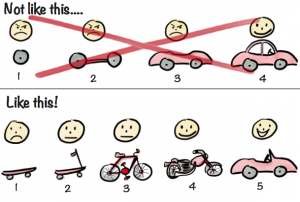
Iterative development of a minimum viable product (MVP) is critical in LPD and probably one of the least understood parts of the cycle by non-practitioners. It is also very hard to estimate effort and time for the development team because it involves an open-ended process with key stakeholders and users. The key issue is to understand what they expect and how they will help you towards viable iterations for validation.
If their understanding is more like the top example in this illustration than the second, it is going to require some real thought to ensure you arrive at validation releases that are fully-formed (loveable) but not feature-rich or too simplistic. This is an element of your work as a whole team where you can really assess the ability of your outsourced team to work fully as a partner in product development. Can they come up with creative ways to give a good representation of the core product to users with less effort and time? Can they see the evolution of ideas and pick out key elements in customer feedback? If you expect or have to micro-manage every iteration yourself, you’re not getting a fully-prepared software development team.
3. How will we capture and manage user feedback during validation and following initial release?
 Now, of course – a developer could just say, «This is your problem, not mine.» To a degree, they would be right, but you are looking for partner-level answers that indicate a willingness to do whatever is needed to make the product development process work properly and to be in position for the long run if your product is likely to benefit from a continuous development/improvement, DevOps-type release. Possible answers can be all over the board from add-on services that support help desk and application feedback to in-app custom modules. At a minimum, developers should be «in the loop» during validation and early release to assure that application bugs are not being reported as feature requests or issues and a system should be available to allow users to see proposed changes and «vote up or down» features they would value.
Now, of course – a developer could just say, «This is your problem, not mine.» To a degree, they would be right, but you are looking for partner-level answers that indicate a willingness to do whatever is needed to make the product development process work properly and to be in position for the long run if your product is likely to benefit from a continuous development/improvement, DevOps-type release. Possible answers can be all over the board from add-on services that support help desk and application feedback to in-app custom modules. At a minimum, developers should be «in the loop» during validation and early release to assure that application bugs are not being reported as feature requests or issues and a system should be available to allow users to see proposed changes and «vote up or down» features they would value.
Including the development team in the feedback loop has a cost, but it avoids a lot of thrash when a feature is not working as expected, allows the developers to be proactive with corrective actions and to understand needs directly from a user’s words, rather than summaries. Again, what you are looking for is not a specific answer but that your partner is willing and able to understand what you need from a product perspective and provide creative solutions.
4. What are our options for capturing user metrics?
This requirement is, of course, very similar to capturing user feedback, so solutions can range from custom reporting within the application to third-party services and application libraries. In this case, the richness of options is key so you can evaluate different aspects of customer acquisition, feature usage, time to complete a process, etc. These features don’t exist in «average» applications, but they can be added relatively easily during development, especially if you compare the effort required to add them at some later point. You will have to get into detail about the kinds of metrics you feel might be most useful for your application and situation, but a strong developer team should be able to give you a range of options for implementation and some sort of dashboard for generating reports.
5. What do you do to assure that quality issues don’t get in the way?
It may seem a bit off point to discuss quality in an LPD focused question set, but the quality is far and away one of the biggest issues when it comes to unexpected project delays. You can’t expect stakeholders and users to be fully engaged in the product development process if planned releases are delayed or major features don’t appear fully formed as promised. A really good application that is unstable or has a poorly designed user interface is a big distraction from the goals of LPD project.
 The best answers to this question include test-driven development, test automation, continuous integration and the tools that could eventually come into play if you choose to go into continuous development. The best case is to make this decision upfront, but things don’t always work out that way. Your primary aim should be to ensure you are in a position to move to that level when you need to without backtracking or having less than full test coverage and to leverage quality assurance tools and processes proactively from the beginning. Your team should be able to focus on feature execution and user experience as they do their acceptance and not buggy code or user interface inconsistencies.
The best answers to this question include test-driven development, test automation, continuous integration and the tools that could eventually come into play if you choose to go into continuous development. The best case is to make this decision upfront, but things don’t always work out that way. Your primary aim should be to ensure you are in a position to move to that level when you need to without backtracking or having less than full test coverage and to leverage quality assurance tools and processes proactively from the beginning. Your team should be able to focus on feature execution and user experience as they do their acceptance and not buggy code or user interface inconsistencies.
The answers to this question should cover many of the issues of how teams will work and communicate. If they don’t, push follow-up questions in that direction specifically. If you have read anything about outsourcing, you already know that successful agile teams require strong open dialog and collaboration. Don’t let easy answers push you off this point. Understand fully how your project will deal with quality, communication, and ownership of the project goals.
 There are a lot more questions you could ask, but these should get you started. The point is to have a conversation with your prospective vendor and come to an understanding of the methodologies they have utilized, the capabilities they bring to the table, and the customer experience you can expect. A conversation can clear up a lot more issues than a written response to an RFI or a proposal for work and give you a better idea if this is a group you can see your team working with. If you are actually looking for a long term partner and not just a team for a short engagement, it would be wise to have that conversation in person – in your offices or theirs. If it requires some travel, it is just part of the expense of finding a good match. It is much better to have your first face-to-face meetings in a positive, forward-looking atmosphere than when a project is underway and you’ve realized that a lot needs to be done to iron out issues.
There are a lot more questions you could ask, but these should get you started. The point is to have a conversation with your prospective vendor and come to an understanding of the methodologies they have utilized, the capabilities they bring to the table, and the customer experience you can expect. A conversation can clear up a lot more issues than a written response to an RFI or a proposal for work and give you a better idea if this is a group you can see your team working with. If you are actually looking for a long term partner and not just a team for a short engagement, it would be wise to have that conversation in person – in your offices or theirs. If it requires some travel, it is just part of the expense of finding a good match. It is much better to have your first face-to-face meetings in a positive, forward-looking atmosphere than when a project is underway and you’ve realized that a lot needs to be done to iron out issues.
Scio is a vendor of outsourced, nearshore software development services to our clients in North America. We provide teams with a background in Lean Product Development as a part of our service portfolio. We use agile methodologies and adapt them to the situation and needs of our clients. If you are interested in how we could partner with your organization to build a great set of new products – Contact Us. We would be glad to take the time to discuss your needs.

Agile Methodology, Customer Experience, DevOps, Nearshore, Product Development, Project Management, Successful Outsourcing
Rotating team members on agile software development teams is a controversial subject. Some leaders in the agile community are strongly opposed to the idea and won’t consider it at any level. Others are open to the subject, but frankly too concerned about the possible downsides to actively plan rotations or even hint to their customers it might be a good idea. And of course, there are the wild-eyed optimists who claim it is the best idea possible for every situation.
Our focus for this article is dedicated teams – teams with members selected for their skills and reliability over the long run. Typically, dedicated teams have no set sunset. They are dedicated to a product or part of a product suite and they generally stay through the active development and maintenance of a product lifecycle – which for enterprise software maybe years. But, that said, the ideas that bring up the subject of rotating members of a dedicated team could apply to any long term project, especially with smaller (3-5 member) teams.
And let’s be honest about one other thing too: the longer the project or product lifecycle, the more likely it is there will be an «unplanned» member rotation. Births, deaths, illness, vacations, career advancements and changes – all sorts of life events have to be managed as a part of maintaining a dedicated team. Even if the time a member is away is relatively short, in less than two weeks, the impact on the productivity of a small team needs to be managed to continue to meet client schedules and expectations. In some cases, the remaining team members can sustain production for a period of time by adding additional hours daily and on weekends, but eventually, that will take a toll on their personal commitment to the team. And when there is an unplanned need to bring in a replacement, there are consequences to the team regardless of the additional manpower provided. In fact, it is well understood that if for some reason two members of a small team needed to be replaced over a short period of time, it would be catastrophic for the team. Bringing the new member «up-to-speed» with mentoring and knowledge transfer takes time and effort of other team members away from their work. And, there is the well-understood impact of a team «forming, storming, norming, and performing» cycles as described by Tuckman. Changing a member of a small team always creates issues. Without some planning and forethought – it can kill the effectiveness of a team for an extended period of time.
So – why would anyone want to consider the idea of rotating team members on dedicated agile teams?
- If unplanned changes in a dedicated team are going to happen anyway, why not be prepared? Why not have the process for selecting, integrating, training and mentoring a new team member planned, documented and tested before it actually happens? Why wouldn’t you want the expectation that «this can happen» and «this is how we deal with it» in place and in front of the team and the client from the beginning?
 The longer a team works on a product, the more likely they are to develop «tunnel-vision.» They see the UI, but they become blind to the problems a new user might encounter trying to use it. They know there are newer technologies that might make something more efficient or resilient, but it takes time to test, advocate change, and demo the option to the client team. If what you have works, is it really worth the effort? The longer a team works together, the more «normal» the little quirks about a product become. In the long run, it can make them resistant to needed change and reluctant to suggest options.
The longer a team works on a product, the more likely they are to develop «tunnel-vision.» They see the UI, but they become blind to the problems a new user might encounter trying to use it. They know there are newer technologies that might make something more efficient or resilient, but it takes time to test, advocate change, and demo the option to the client team. If what you have works, is it really worth the effort? The longer a team works together, the more «normal» the little quirks about a product become. In the long run, it can make them resistant to needed change and reluctant to suggest options.- Working with the same people, on the same product, eventually leads to a level of isolation that can begin to make it difficult to want to get started on the «same old stuff» each day. Developers are part of «geek culture» and love to see new technologies, get input from other sources and try «cool» things. When this happens, production slips and members of the team may become less committed to the success of the product they are working on. It doesn’t happen in a day; it is a slow drip that eventually eats away at the team and makes it less effective. It can also make individuals on the team consider career changes because they are afraid their resume will reflect stagnation rather than stability.
- Bringing in «fresh (but experienced) blood» can bring cross-pollination from other experiences, new points of view on coding practices and processes, a new look at alternatives as you move forward and other benefits from another set of eyes on the project. If long term members of the project are not ready to accept new ideas, they can create strong resistance, but if they are positively primed for the idea by considering they could also benefit individually and as a team, it can be a shot in the arm for the team.
- «Ownership» of a product, or an area of responsibility, can be a strong motivator for a team. Their understanding of its deeper value and continued success is part of their pride and keeps the team on track. But, there is also a downside. If the team is the single point of knowledge and «truth» for a product, they are also the single point of failure. If there is no base of knowledge about the product outside of the team, in the wider pool of developers around them, there is no way to replace a team member easily or help them if there is a problem that causes a loss of a member or if the team runs into a serious internal disagreement (it does happen).
- Operationally, these long-term teams become silos. Outside the team, they are the go-to subject matter experts that always have the answers. Inside the team, individuals tend to become specialists, filling a niche that no one else can come close to. This not only runs against the whole concept of «agile organizations» – it becomes a growing risk within the organization.
There are more reasons too – but those concerns represent some of the more common drivers of the idea. They are all real issues and the problems the teams dealing with them have an impact on the projects they are in. But – does planned rotation actually solve the problems? Does the upside outweigh the downsides? Can rotation be planned well enough to overcome internal team dynamics? Will the supposed benefits last long enough to make rotations something you want to do? Can you actually present a case that would make client support, rather than oppose, the practice?
The answer would have to be – it all depends on implementation.
- Like any change, member rotations have to be sold internally before they can be implemented.
- Frank conversations about the health of teams, experiences in long term engagements have to be surfaced and alternative solutions have to be discussed.
- The timing and requirements for new members have to be considered and accepted by the existing team members. Simply dumping the idea on them without preparation is sure to bring disaster.
- The level of the incoming team member will make a difference in acceptance. Replacing a senior member with another senior developer may be more difficult than bringing in a mid-level or junior developer in their place. With less seniority, the new member will have lower expectations and less to live up to. They will be more accepting during knowledge transfer and mentoring and give existing team members new opportunities to grow. But if the outgoing member is considered to be a team leader, the impact may be very deep no matter who is brought in.
- If the practice is fairly new within the organization, replacing a team member is likely to be more problematic regardless of planning and thought. The practice can be new institutionally or within the team, it really doesn’t matter. If team members are not experienced with the concept, issues will arise. Assuming the issue will iron themselves out eventually is not a good way to manage change.
- Frequency is important. Single-member rotation will always cause thrash and lost productivity no matter how well it is planned. A team can only sustain so much change without becoming distracted and losing their center. In complex environments, it may take a considerable time for a new member to build up the necessary knowledge base. Most industry experience seems to circle around a period between six and nine months for the change of one member. More than that and the team might never gain cohesion again. Less than that and silos will begin to form. But, there is no perfect point. You can’t change a member during a critical release for a product, no matter what the calendar says. You have to work with the client team to gain acceptance and cooperation. Timing is a hard nut to crack and will be different in every situation.
This is an important and evolving area of management for outsourced agile teams. It is not widely discussed in the software development industry. Clients come to outsourcing vendors to avoid issues like team cohesion, resilience, and long-term stability. It may be difficult to bring them into a conversation about an issue that is seen as a vendor responsibility.
But, there are some ideas that are coming forward and worth considering. Larger outsourcing vendors can propose a dedicated «pool» rather than a team. The actual team in production continues to be a small number, but the vendor commits to a larger group, perhaps 7-10 including the active team, of developers that are involved and can become a team member with less overhead from change. This allows the members of the pool to become involved in project and product discussions, review code, and be the sounding board for ideas. There has to be an adjustment of the cost to allow this kind of an arrangement and a clear commitment by the vendor to avoiding the issues that are considered part of dedicated team contracts, but in certain situations, it is worth considering.
In the final analysis, it is hard to value the practice of rotating team members on dedicated teams. It can seem like a great idea if you have experienced the downsides of long-term engagements where unplanned changes and team stagnation become barriers to success. If the motivation, implementation, and outcomes are not carefully considered and monitored, it can become a serious distraction from productive development. Neither outcome is good so this is an important consideration and the decisions are likely to be different in every situation.
If you have experience with team member rotation (and not just fears or wild optimism) – I would be interested to hear your thoughts. This is still an unsettled area in agile team dynamics.
Scio is a provider of outsourced, dedicated and project teams for agile software development to our nearshore clients in North America. We have experience with many team and project configurations and would love to discuss how we could help with your next project. Please contact us with your questions.

Agile Methodology, Customer Experience, Nearshore, Product Development, Project Management, Successful Outsourcing
Work is always measured in some way. If you are doing repetitive work, the tendency is to measure the number of repetitions, like the pounds of fruit picked by a field worker in an hour or a day. If you are doing knowledge work, the tendency is to simply measure hours of work spent on the problem, assuming that a) the person doing the work has the necessary set of skills and a comprehensive knowledge base of the subject at hand and b) they spent enough time to evaluate the problem sufficiently and provide a balanced solution. If you are doing time and/or payment-dependent contract work, the main consideration is did you complete the work assigned in the contracted period and at the specified cost?
This all seems relatively benign and normal in the world of work because it assigns a value to work that can then be measured and evaluated in various ways. Did you pick more fruit this week than last? Did you solve more problems in this quarter? Did you complete all your contracted work on time and budget?
Software development is, of course, one of the most valuable types of knowledge work being done globally today. Since development is usually the domain of teams and is at this time, largely done with some form of agile and/or lean methodologies, the measurements tend to be a combination of individual and team metrics applied by various means. Some common metrics are:
When we get beyond these three common methods and their minor variations, we start getting into more complex models (!!) that tie team performance, quality, project length, man-hours, adherence to production and methodology standards and complex team models in DevOps implementations.
We Have Questions
At the end of the exercise, however, it is done, we end up with some sort of measurement of the work of software development. But as we do, we need to ask ourselves a few important questions:
 What does our measurement tell us? What is it not telling us? If we are measuring lines of code or functions, is the measurement telling us if the work was efficient or just an output meant to produce more (or a given number of) lines/functions over a given period? Were the lines of code or functions really efficient and useful? Programming is very comparable to writing. Some writers are more efficient at expressing thought and others see a more elegant way to express a thought without addressing it directly. Some programmers are more efficient because they reuse code multiple times throughout the source with efficient use of variables. Some functions in a program are critical and getting them right is tough, requiring time and effort. Other functions are simply «eye-wash» and don’t have a real bottom-line value. There as many ways to game the system as there are ways to produce better code with fewer lines. Every programmer, every team, and every project has different dynamics depending on the language being used, the type of environment, the technical problem being dealt with and many other factors. If you use a pure «number of X metric,» you have to be clear about what it means and doesn’t address.
What does our measurement tell us? What is it not telling us? If we are measuring lines of code or functions, is the measurement telling us if the work was efficient or just an output meant to produce more (or a given number of) lines/functions over a given period? Were the lines of code or functions really efficient and useful? Programming is very comparable to writing. Some writers are more efficient at expressing thought and others see a more elegant way to express a thought without addressing it directly. Some programmers are more efficient because they reuse code multiple times throughout the source with efficient use of variables. Some functions in a program are critical and getting them right is tough, requiring time and effort. Other functions are simply «eye-wash» and don’t have a real bottom-line value. There as many ways to game the system as there are ways to produce better code with fewer lines. Every programmer, every team, and every project has different dynamics depending on the language being used, the type of environment, the technical problem being dealt with and many other factors. If you use a pure «number of X metric,» you have to be clear about what it means and doesn’t address.- Is our measurement comparable? Can it be used over the long term or compared across projects or teams? Frequently, this is where the complex math becomes part of the equation and frankly, begins to fail to do its job effectively. The more we try to «normalize» measurements across a single project, between teams, and across projects and teams, the more subjective the outcome becomes. Were the technical hurdles encountered at the beginning of Project A really comparable to Project B? If we decide there is a significant difference, how do we adjust for it? Did Team A experience more changes in team composition than Team B? How do we account for that issue? Are we comparing skill levels, experience, time to reach «normal productivity» or some other factor? Was Team A really suited to provide the skills and experience needed for the given project? Did their productivity fail to reach the levels expected because of issues outside of their control? In most cases, the more you try to normalize between measures of productivity between individuals, teams, and projects, the less sure you can be you have a reasonable common measure. And in the end, the question becomes, is a comparable metric what we really need?
 Isn’t any measurement better than no measurement? Can we afford to fly blind? Certainly, if you have an outsourced team, multiple teams, and/or multiple projects you have to begin to understand why some projects seem to work well and some don’t. You need to be able to judge if a project is going off the tracks so you can get it back in line before the problem becomes critical. Finding ways to measure performance and productivity would seem to be the best tool to address the common issues in software development projects. But if the measurements we are using aren’t really addressing the problems we have, how are they helping us? Are they really more than just busy work for managers and bean counters?
Isn’t any measurement better than no measurement? Can we afford to fly blind? Certainly, if you have an outsourced team, multiple teams, and/or multiple projects you have to begin to understand why some projects seem to work well and some don’t. You need to be able to judge if a project is going off the tracks so you can get it back in line before the problem becomes critical. Finding ways to measure performance and productivity would seem to be the best tool to address the common issues in software development projects. But if the measurements we are using aren’t really addressing the problems we have, how are they helping us? Are they really more than just busy work for managers and bean counters?
The more we look at the problem, the more we begin to understand that measurement for the sake of monitoring «something» isn’t really useful. But on the other hand, measuring any aspect of software development is better than monitoring nothing at all and simply hoping everything will work out in the end. Even a weak measurement provides some level of confidence if it is used consistently and we understand its shortcomings well enough.
In agile teams, there is another, more important way to look at things. If we give the team simple methods they agree on and understand, like story points and burn down charts, they will know when they are performing well and when they are pushing too large a boulder up a hill. Inside the team, they know who is consistently performing and producing efficient code with fewer problems. The team knows when its backlog is too great to finish in the allotted time. Team members learn quickly who can be asked for pointers on how to approach a problem properly and who cannot be depended on reliably. We can stand around, pointing out issues with the common ways to measure agile team performance, but their value is those common agile methods are basically useful to the team to understand where they stand in relation to the work ahead of them and their quality performance. Where we get into trouble is when we try to extract the common measures and try to draw larger conclusions from them.
The Reality is – Communication is the Key
If we get past trying to use performance metrics outside of a single project and narrow our focus to what they do for a team inside of a project, we begin to see their value more clearly. The team knows what is going on. They may attempt to fool themselves or others, but in the end, they can see the light in the tunnel and they know if it is a successful end to the project or an approaching train. The problem is to get them to trust each other and the larger team enough to surface the problems they see as soon as they see them, without fear.
The level of trust and responsibility required for open communication and collaboration is perhaps the largest problem faced in software development projects. It is the «why» behind the invention and popularity of the agile and lean methodologies in wide use today. Conversely, the larger the organization, the more critical and costly the project is to the organization, the less likely it is that the team will feel and be enabled to inquire and speak out about the problems they believe they are facing. In a large organization, metrics are the shorthand to avoid having «high touch» with every team and individual. In a costly, critical project, metrics are meant to be the «truth-tellers» to assure stakeholders that things are well controlled, even though everyone knows that metrics can be gamed without much problem. And the more the metrics are relied on, instead of the knowledge inside of the team, the more likely it is the project will get out of hand before the problems are addressed.
Responsibility. Trust. Communication.
So what is the bottom line on measuring performance and productivity in software development projects?
- Measurement is most useful inside the software development team itself,

Planning Poker
where the knowledge resides about what is really going on from day today. Everywhere else, it is just as likely to be smoke and mirrors as it is, to be honest, and useful – depending on who is using the metrics and for what purpose. If the team doesn’t understand the metrics applied and can’t use them to better understand where they are in relation to the work to be done, their quality performance and general efficiency as a team, the metrics will fail to give back their primary value – keeping the team and project on track.
-
The agile methodology relies on individual and team responsibility, trust and communication. If these three points cannot be achieved within a team, agile and scrum are just a bunch of processes and procedures that may or may not be helpful in organizing work. If the team is just «going through the motions» in taking responsibility for tasks, assessing and managing their backlog, and participating in standups and retrospectives, additional metrics and measurement will not provide much value. They will provide information to a larger audience too late to enable outside forces to do more than triage injuries to the project.
- Working through what may appear to be problems or what may seem to be a simple solution requires peer-level coaching and communication, not blame. If we understand that the team itself really knows what is going on – getting them to assess the problem honestly and figure out how to address it requires something other than pointing fingers, avoiding issues and top-down communication. It also means that the team needs to take responsibility, as soon as anyone recognizes a problem could be on the horizon, to consider it seriously and determine both the size of the problem and solutions that could be used to address it. And so what if the team raises an issue that may turn out to be nothing of great importance? We’ve been called to action to look at it and we will all come out of the conversation wiser. If everyone in the conversation addresses each other as a peer, rather than hierarchically, there is a good reason to think that the next time a problem is encountered or perceived, it will be openly addressed, rather than swept under the rug.
Three points to consider and use in conjunction with standard agile and scrum-based tools. You can use more and you can draw all sorts of conclusions from the systems you bring together. But in the end, if they don’t bring immediate value back to a current project, what value are they really serving?
Looking for a development team? Contact us we can help you!
Scio provides nearshore software development services for our client base in North America. We work closely with our clients to ensure that the projects we are involved in have the level of communication and understanding needed to reach successful outcomes. If you have a project where you think we could help, please contact us. We would be happy to discuss your needs.

Agile Methodology, Customer Experience, Nearshore, Project Management, Successful Outsourcing
Do you have experience with outsourcing software development through an offshore vendor? What were some of the problems you faced? What problems did you recognize? What problems were glossed over in the final analysis that contributed to less than optimal results? What are your major concerns in offshore outsourcing?
It is no secret that offshore software development is a challenge beyond the usual issues in almost any IT project. Certainly there are successful projects – but what issues do businesses face when starting offshore development projects? Let’s break them down into five major areas:
1. Best Case Situations for Offshore Projects
Is your project a strong candidate for an outsourced, offshore engagement? Consider a few factors that can make or break the project from the start:
- Do you have good experience with the offshore outsourcing, the vendor, the size and type of project you are considering? Does your team? If the answer to any of these questions is not a clear, «Yes!» – you are facing an uphill battle.
- Is your internal goal for the project clear and well-understood across your organization? Is it well-accepted? In most cases, outsourced projects have several drivers, but they must be clear and rational in the current situation to be accepted. Common drivers for outsourcing are cost savings, access to resources and skills, and improved time-to-market because the project is expected to overcome some internal barriers to getting the project completed within constraints.
- Does your project fit well in situations where communication may be limited and operations (within the outsourced team) may be different than your own? In other words, can you describe your project in these terms?
- Application requirements are straight-forward, well-described and STABLE (like a rock!). No changes are contemplated.
- Application is not complex and technology required is not new or debatable. In total, the project is not groundbreaking
- Functionality is documented and well-described in a user context.
- Application is not large. It can be broken down into several, small, independent modules.
- Project is not mission-critical or considered to be risky based on projected cost and time.
Of course, covering all these issues would make any outsourced project more successful, but it would also make them a bit of a unicorn in the world of IT. In the final analysis, very few (if any) projects have stable requirements throughout their development cycle. As functionality is developed, it is natural to look deeper and consider outcomes in a different light. But, if your project is one of those golden unicorns – then even your first offshore project has a decent chance of success. If your project doesn’t fit into a best case scenario for offshore, you need to be aware that mitigations for shortcomings have costs and may drive you into corners that are difficult to escape.
2. Failure to Disconnect People and Problems
 This issue is a problem across outsourcing but of particular importance in offshore relationships. When problems are perceived during a project, they are most often traced back to an individual or team, not the processes or operational procedures in place that created the environment where the problem happened. Instead of examining the situation, organizational norms, processes and methods (and their implementations), we have a strong tendency to look for a scapegoat, a person that is at fault. This leads to a loss of trust within the team as a whole and enforcement of hierarchical control – exactly the opposite of what we need if we depend on a strong, agile team to function properly. Increased hierarchy means less direct communication with developers and conversely, less independent thought from people whose skills as «knowledge workers» makes them valuable. In an offshore situation, this can be fatal to project outcomes if there is not full-time, offshore and onshore coordination and management – which of course – raises costs and lowers productivity. And because once we have targeted an individual rather than other factors, we are very likely find ourselves repeating the same problems over and over, in slightly different configurations.
This issue is a problem across outsourcing but of particular importance in offshore relationships. When problems are perceived during a project, they are most often traced back to an individual or team, not the processes or operational procedures in place that created the environment where the problem happened. Instead of examining the situation, organizational norms, processes and methods (and their implementations), we have a strong tendency to look for a scapegoat, a person that is at fault. This leads to a loss of trust within the team as a whole and enforcement of hierarchical control – exactly the opposite of what we need if we depend on a strong, agile team to function properly. Increased hierarchy means less direct communication with developers and conversely, less independent thought from people whose skills as «knowledge workers» makes them valuable. In an offshore situation, this can be fatal to project outcomes if there is not full-time, offshore and onshore coordination and management – which of course – raises costs and lowers productivity. And because once we have targeted an individual rather than other factors, we are very likely find ourselves repeating the same problems over and over, in slightly different configurations.
3. Travel & Communications

Of course, the reason that travel and communication issues are strongly linked is that – in outsourcing you travel to facilitate better communication. Regardless of all the advances of technology, face-to-face communication is still the richest, most efficient form of communication in the design, development and production of custom software. If you want to achieve trust, a shared understanding of a product, a clear picture of your entire team (outsourced and inhouse as one), there is no better way to do it than getting everyone together in one place. Barring that – you can also achieve a lot by getting key resources together to kick off a project but there is still a deficit in communication across the team that only direct contact can overcome quickly. In addition, the experience of direct contact also holds longer within the team – enabling true collaboration across the project lifecycle.
But if hourly labor costs are considered to be part of the project drivers, the reality is that the best prices for labor on an hourly basis are likely to be in fairly distant, even remote locations. This means that travel by key personnel to or from the outsourced vendor home area is likely to occur over a longer period and many «hops.» Although the key outsourcing centers in India are not remote by today’s standards of global business, they are a considerable commitment in time and cost. You might think you can get by with inexpensive flights, accommodations and simple food – but after several days of low budget travel you are likely to find you are not at your peak in critical business meetings. The same will be true for teams coming to you from a distant location. In that case, it is more than a few amenities that can get in the way. Visas, entry processes, unfamiliarity with local customs and expectations can all become barriers to having a productive few days after a long trip.
In projects with some uncertainty, this issue of time and cost can delay travel that would be beneficial to communication until a situation becomes critical. Travel avoidance creates situations where meetings that should be cordial, collaborative discussions become frustrating negotiations that are more likely to be «lose-lose» than «win-win.»
But let’s say your project is fairly straight-forward and although there is some uncertainty, you have enough cash to allow for more than one trip with your key resources at a minimum. What other areas in communication do you have to consider in offshore situations?
 Language – Although English is certainly the language of business around the world, it isn’t everyone’s native language and although many people can read English, not everyone can write and discuss ideas verbally with the same proficiency. In addition, culture and local contexts are part of understanding each other, no matter what language is spoken. A common spoken word in one location may have no direct counterpart in another location. My «door jamb» is funny if you understand what you hear as «jam» only makes sense as a form of marmalade. If a member of your team has very little conversational experience in English, it is likely they just won’t speak in meetings because they are afraid they might say the wrong thing and they can’t follow the conversation completely. As these barriers rise, so do the work-arounds. A facilitator or go-between is added to «ensure clear communication» but in the process of clarifying they also over-simplify and leave out critical details. A translation point is added so each side doesn’t have to deal with complex issues in a language they are not familiar with but because the translator isn’t a technical or business expert, many nuances are lost in translation.
Language – Although English is certainly the language of business around the world, it isn’t everyone’s native language and although many people can read English, not everyone can write and discuss ideas verbally with the same proficiency. In addition, culture and local contexts are part of understanding each other, no matter what language is spoken. A common spoken word in one location may have no direct counterpart in another location. My «door jamb» is funny if you understand what you hear as «jam» only makes sense as a form of marmalade. If a member of your team has very little conversational experience in English, it is likely they just won’t speak in meetings because they are afraid they might say the wrong thing and they can’t follow the conversation completely. As these barriers rise, so do the work-arounds. A facilitator or go-between is added to «ensure clear communication» but in the process of clarifying they also over-simplify and leave out critical details. A translation point is added so each side doesn’t have to deal with complex issues in a language they are not familiar with but because the translator isn’t a technical or business expert, many nuances are lost in translation.
 Time Differences – In offshore situations, the working day time difference between teams can mean that there is no overlap or that there is only one or two hours in a day when some direct contact can be made. Even when accommodations are made, it is generally done by putting one or two people in the combined team at a disadvantage. If the product owner makes themselves the key point of contact, they will have to find time to accommodate the outsourced team and their local team members which can result in some very odd and frustrating hours. If a local technical manager and a distant technical manager are implemented (as is often the case), communication fidelity is lost because the production team and the product owner are not in direct communication most of the time. There are many variations of workarounds for time differences, but for software development projects, this can be a very significant issue and barrier to good project communication.
Time Differences – In offshore situations, the working day time difference between teams can mean that there is no overlap or that there is only one or two hours in a day when some direct contact can be made. Even when accommodations are made, it is generally done by putting one or two people in the combined team at a disadvantage. If the product owner makes themselves the key point of contact, they will have to find time to accommodate the outsourced team and their local team members which can result in some very odd and frustrating hours. If a local technical manager and a distant technical manager are implemented (as is often the case), communication fidelity is lost because the production team and the product owner are not in direct communication most of the time. There are many variations of workarounds for time differences, but for software development projects, this can be a very significant issue and barrier to good project communication.- Us Versus Them – In any situation with two teams in different locations, there is always a barrier to getting the team to think as one unit with shared goals and responsibilities. In offshore situations, the teams face significant barriers of culture, language, vendor-to-client relationships, and time differences together. If things go wrong at some point, the tendency to blame and in many cultures, accept blame without question, can deepen the divide between teams. Trust, the ability to speak openly and discuss issues without fear is a serious problem in offshore teams on projects with shifting requirements and critical outcomes.
- Business Domain Sharing – Every successful business has internal, proprietary knowledge is part of their key business advantage. Sharing that knowledge openly; answering questions with proper context and depth takes time, though, and trust. In outsourcing, particularly in offshore situations, sharing proprietary knowledge can be very difficult. Legal concerns, technical business language, access to subject matter experts (SMEs) in real time, and the dense, technical documentation that is often generated to overcome issues can become barriers to productivity instead of bridges to understanding. Few teams understand at the outset how difficult business domain sharing can be and how important it is to developing a critical application that fits a business model well.
- Frustration Overhead – All these points add up to a level of frustration on the project team that makes it very hard to work together and deal with ordinary project issues. The development team becomes frustrated when they can’t clarify requirements with the product owner or SMEs in a timely fashion. The product owner becomes frustrated when (because requirements couldn’t be clarified in a timely fashion) functionality is developed that isn’t what they wanted. The internal QA becomes frustrated when code and UI quality doesn’t meet their standards for maintainable code and usability. When communication is limited to a few issues at that are considered to be critical in the moment, these frustrations build and create deep divides and barriers. It is rarely discussed, but the mental load of built-up frustrations is a big contributor to low productivity and project failure.
4. Technology & Methodology Differences
Globally it may seem that people in technology are all in sync – but that is a big assumption. Regionally, the access to new technology may be limited by licensing, educational resources, access to technical information, experience and local preference. The gaps in methodologies can be even greater. An offshore team is limited in their implementation of agile by the circumstances of their location in relation to their clients. Real-time communication and collaboration, the cornerstone of agile, is at a premium if it exists at all. DevOps practices and experience may not exist in the their context.
In these situations, offshore teams have to deal with several issues that can be critical factors in project success:
- Are the development platforms and systems the offshore team is experienced with appropriate for productivity and the target application? Will there need to be training and alignment to reach a solid, common platform?
- Are their operational practices compatible and up to standards? Is their implementation stable and dependable?
- Is their implementation of agile fully functional or so limited by communication delays and cultural differences that it is barely recognizable?
- How is their QA done? Is it tightly integrated into development practices and responsibility or completely separate and walled in? Will it integrate seamlessly with your functional QA or will quality and communication issues create endless loops and finger-pointing?
- Is their coding productive, up to standards and maintainable? How much time and oversight on coding issues can you have in an offshore situation where the team is operationally separated by many hours? Is their team biased to keep hourly costs low (more junior resources with low experience versus senior resources)? Do they practice mentoring, code review, and have a learning atmosphere (versus blaming)? These things are hard to know if you cannot interact with individual members of the development team regularly without barriers.
- Do they have small, skilled teams or large teams with lots of communication overhead? Is their turnover high or low and stable? In many emerging economies, turnover on technical teams can be very high because of competition for good-paying jobs and resources.
These issues can be dealt with by experienced, motivated offshore service vendors, but understanding the issues they are dealing with is very important.
5. Social and Organizational Differences
In many ways, the social and organizational issues in offshoring are similar to the other areas we have mentioned. Organizations in the US tend to be flat (or at least flatter) than their offshore partners. Hierarchical cultures and organizations don’t foster the independent thought, responsibility and soft skills that form the backbone of the agile software development methodologies in wide use today. That doesn’t mean offshore resources can’t function fully as agile teams, but it does infer there are problems to be considered and dealt with to be successful.

Might seem risky but is it really? Depends on many factors.
All outsourced teams have a certain amount of risk adversity. It is much easier to go with the easy choice rather than consider something new that the team may be less experienced with even though it may have great benefits. This is even more true when the team is separated from their client team by communication barriers. Offshore teams face a double burden of hierarchical culture and low communications efficiency. They may be very adverse to suggesting alternative approaches because if there is any risk, they feel they are taking on themselves rather than operating as a trusted part of the whole project team. The issues of risk adversity also trackback to general business practices in other cultures. Client – vendor relationships can be very different outside of the US.
And finally, along with a high turnover rate in a competitive atmosphere for skilled resources, there is a tendency in software development teams to feel a lack of challenge and access to new technologies. This is especially true in emerging economies where the access to advanced technology and challenging assignments may only come from companies providing outsourcing to US and European companies. What from a distance may appear to be a stable job in a long term project on a big team becomes a career killer in an emerging economy. Keeping a sense of ownership, shared opportunity and trust is more challenging when your offshore team doesn’t understand or share a level of personal context with you.
Forget all your concerns in Offshore Outsourcing. What is the Alternative?
Ok – but really, even with a high level of project failure for offshore software development projects, there are many successful outsourcing engagements – or no one would ever do it. Experience does count and knowledge of the bumps in the road is very helpful. Keeping projects relatively small and low risk is of course a simple alternative, but it is not efficient in the long run if you actually have big goals.
I wouldn’t be honest if I didn’t admit a bit of bias here. Scio is a nearshore vendor for outsourced software development to our clients in North America from our development center in Mexico. That means that although we are subject to all of the normal issues in the field of outsourcing, our practices and focus give us an advantage when it comes to communication and a lot of the factors we have mentioned in this article. We can work in real time with our clients. We have at least a six hour working day overlap with our client teams and most of the time, we have seven to eight hours when we are available to work and communicate directly across our project teams. We share most the concerns and elements of North American identity and culture. We are fully aware of and have worked with US teams, indirect communication and collaboration with them as individuals. We have access to the same infrastructure, technology, standards and processes. We can collaborate in conversational English without barriers. After all, we neighbors – sharing many aspects of North American life transparently. Travel to our clients in the US or from our clients to us is not much different than travel across the US. Visa access for business is part of the NAFTA trade agreement.
If you are looking for an unfair advantage at the level of hourly wage, our costs are not as low as those in emerging Asian economies, but when it comes to Total Cost of Engagement (TCE) our costs fall into line but with less risk and complication. Nearshore is not a silver bullet – but if you are facing issues when it comes to resourcing a team and you can’t deal with the risk that comes with offshore in projects that could have unstable requirements – an experienced agile team that can work with you as a partner in real-time, in direct collaboration with your team, can be a serious advantage.
Do you need an outsourcing partner? We want to help you
Are you interested in a serious advantage in your next software development project? Scio is a nearshore vendor of outsourced services for software development to our client base in North America. We understand the needs and issues our clients face and actively partner with them to find solutions and make their projects successful. If you would like to know more about what we could do for you – contact us.
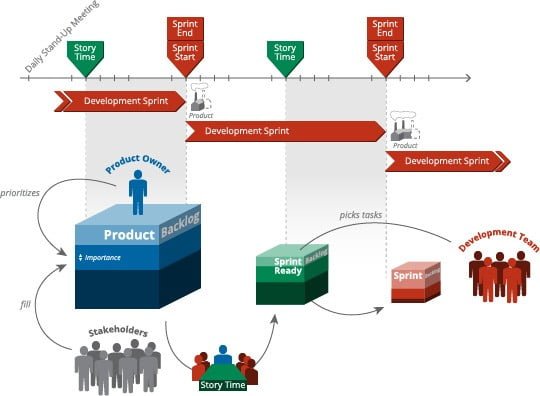
Agile Methodology, Customer Experience, Nearshore, Product Development
Common Myths & Misconceptions for Distributed Agile Teams in Software Development
Throughout this series, we have explored some of the best practices for agile-scrum teams, but in the light of distributed team situations. Scio provides software development teams – working from our development center in Morelia – for projects throughout North America. Our practices, methodologies, and culture are tuned to distributed team situations in a nearshore deployment. We discuss the realities of outsourcing and distributed teams with our prospects and clients on a regular basis. As we wrap up this series, let’s discuss some of the common myths and misconceptions that we hear about frequently.
There is no additional overhead for projects using distributed teams for agile-scrum projects.
Reality: Shared vision, communication, strong procedures, and planning are part of the required overhead for working smart in a distributed team environment. But, the truth is – these same elements should be part of any software development project to ensure success. While a distributed environment requires more rigor and attention to details, all projects benefit from addressing these issues.
More specification must be done at the start of a distributed team project
Reality: Increasing the upfront development of specifications for an agile-scrum project creates a false sense of security and understanding. When something needs to change, there will be latent resistance. There is an increased focus for the full team on understanding where the team(s) are and assuring knowledge is shared – but that should be a normal part of communication in any situation.
Distributed teams cannot do agile and scrum
Reality: If teams are able to organize independently, are cross-functional, collaborative, etc. – there is an overhead in coordination between teams (scrum of scrums) but mitigation in the form of improved awareness of the state of tasks can keep it to a minimum. It is much better to spend resources on coordination than fixes because one team went off the track, wasting time and resources.
Distributed teams have lower quality, more redo’s
Reality: If teams are cross-functional, managing their own tasks and backlog, enabled to work directly with the product owners, have a full development environment using test-driven development, continuous integration and practice regular builds on the central repository for the project, a great number of problems can be avoided. Regular team-wide meetings for planning, pruning, technical issues are overhead, but they will lower impediments greatly if done with openness and trust.
In larger projects, it is better to work as one team than two or more smaller teams even if some members are not co-located with the majority of team members
Reality: The communication and planning overhead does not go down in one larger team in comparison to two or more smaller teams, it rises. Size matters – smaller, self-organizing teams are more efficient overall. Team members in a larger team have less push to be individually responsible and to participate actively in the project. They can easily «hide» in the larger team. In larger teams, the overhead for work review actually climbs, because of the number of people who have to be informed and communicated with. And if the «larger team» is composed of remote members without properly recognizing them as distributed teams or single outside team members – the adherence to standard methodology, processes and assurance procedures tends to drop dramatically. They are literally «out of sight, out of mind.»
There are a lot more things that could be said, but the bottom line is – best practices matter in all agile-scrum projects. Agile is not a license to operate without structure – quite the opposite. It depends on individual responsibility, communication, and adherence to the processes and methodologies adopted by the project team. Agile is adaptive. It will scale along with scrum to situations with distributed teams. Teams that adopt the practices and procedures necessary to be successful in distributed situations as a part of their regular work patterns will have better results in all situations.
We hope this series has been useful and informative for you – helping you to understand what is «behind the curtain» in successful projects and some of the lessons we have learned in the field. If you have a project that you believe could benefit from a team that understands how to leverage agile and scrum in a nearshore implementation, don’t hesitate to contact us.



 But that is the rub. We’re examining a scenario where they need to extend themselves into new technologies and possibly change their operations significantly. And because we’re assuming their teams are informal, separate silos – we’re also assuming they know about the higher efficiencies they could achieve if they began to shift to a DevOps methodology but – again, like our second scenario, they have existing customers and products/services in the field to maintain and support. Like most companies in this situation, their backlog of feature requests for their existing software is just what they can handle at the moment. Adding another layer of work would just mean something would have to give. An outsourced development team, in this case, makes sense and this organization is likely to have customer-facing product development well-in-hand. But, what they don’t have is a scalable organization to match the importance of the project and a broad understanding of new technologies and architectures they need to consider to streamline their organization.
But that is the rub. We’re examining a scenario where they need to extend themselves into new technologies and possibly change their operations significantly. And because we’re assuming their teams are informal, separate silos – we’re also assuming they know about the higher efficiencies they could achieve if they began to shift to a DevOps methodology but – again, like our second scenario, they have existing customers and products/services in the field to maintain and support. Like most companies in this situation, their backlog of feature requests for their existing software is just what they can handle at the moment. Adding another layer of work would just mean something would have to give. An outsourced development team, in this case, makes sense and this organization is likely to have customer-facing product development well-in-hand. But, what they don’t have is a scalable organization to match the importance of the project and a broad understanding of new technologies and architectures they need to consider to streamline their organization.




 Now, of course – a developer could just say, «This is your problem, not mine.» To a degree, they would be right, but you are looking for partner-level answers that indicate a willingness to do whatever is needed to make the product development process work properly and to be in position for the long run if your product is likely to benefit from a continuous development/improvement, DevOps-type release. Possible answers can be all over the board from add-on services that support help desk and application feedback to in-app custom modules. At a minimum, developers should be «in the loop» during validation and early release to assure that application bugs are not being reported as feature requests or issues and a system should be available to allow users to see proposed changes and «vote up or down» features they would value.
Now, of course – a developer could just say, «This is your problem, not mine.» To a degree, they would be right, but you are looking for partner-level answers that indicate a willingness to do whatever is needed to make the product development process work properly and to be in position for the long run if your product is likely to benefit from a continuous development/improvement, DevOps-type release. Possible answers can be all over the board from add-on services that support help desk and application feedback to in-app custom modules. At a minimum, developers should be «in the loop» during validation and early release to assure that application bugs are not being reported as feature requests or issues and a system should be available to allow users to see proposed changes and «vote up or down» features they would value. The best answers to this question include
The best answers to this question include  There are a lot more questions you could ask, but these should get you started. The point is to have a conversation with your prospective vendor and come to an understanding of the methodologies they have utilized, the capabilities they bring to the table, and the customer experience you can expect. A conversation can clear up a lot more issues than a written response to an RFI or a proposal for work and give you a better idea if this is a group you can see your team working with. If you are actually looking for a long term partner and not just a team for a short engagement, it would be wise to have that conversation in person – in your offices or theirs. If it requires some travel, it is just part of the expense of finding a good match. It is much better to have your first face-to-face meetings in a positive, forward-looking atmosphere than when a project is underway and you’ve realized that a lot needs to be done to iron out issues.
There are a lot more questions you could ask, but these should get you started. The point is to have a conversation with your prospective vendor and come to an understanding of the methodologies they have utilized, the capabilities they bring to the table, and the customer experience you can expect. A conversation can clear up a lot more issues than a written response to an RFI or a proposal for work and give you a better idea if this is a group you can see your team working with. If you are actually looking for a long term partner and not just a team for a short engagement, it would be wise to have that conversation in person – in your offices or theirs. If it requires some travel, it is just part of the expense of finding a good match. It is much better to have your first face-to-face meetings in a positive, forward-looking atmosphere than when a project is underway and you’ve realized that a lot needs to be done to iron out issues.



 What does our measurement tell us? What is it not telling us? If we are measuring lines of code or functions, is the measurement telling us if the work was efficient or just an output meant to produce more (or a given number of) lines/functions over a given period? Were the lines of code or functions really efficient and useful? Programming is very comparable to writing. Some writers are more efficient at expressing thought and others see a more elegant way to express a thought without addressing it directly. Some programmers are more efficient because they reuse code multiple times throughout the source with efficient use of variables. Some functions in a program are critical and getting them right is tough, requiring time and effort. Other functions are simply «eye-wash» and don’t have a real bottom-line value. There as many ways to game the system as there are ways to produce better code with fewer lines. Every programmer, every team, and every project has different dynamics depending on the language being used, the type of environment, the technical problem being dealt with and many other factors. If you use a pure «number of X metric,» you have to be clear about what it means and doesn’t address.
What does our measurement tell us? What is it not telling us? If we are measuring lines of code or functions, is the measurement telling us if the work was efficient or just an output meant to produce more (or a given number of) lines/functions over a given period? Were the lines of code or functions really efficient and useful? Programming is very comparable to writing. Some writers are more efficient at expressing thought and others see a more elegant way to express a thought without addressing it directly. Some programmers are more efficient because they reuse code multiple times throughout the source with efficient use of variables. Some functions in a program are critical and getting them right is tough, requiring time and effort. Other functions are simply «eye-wash» and don’t have a real bottom-line value. There as many ways to game the system as there are ways to produce better code with fewer lines. Every programmer, every team, and every project has different dynamics depending on the language being used, the type of environment, the technical problem being dealt with and many other factors. If you use a pure «number of X metric,» you have to be clear about what it means and doesn’t address.


 This issue is a problem across outsourcing but of particular importance in offshore relationships. When problems are perceived during a project, they are most often traced back to an individual or team, not the processes or operational procedures in place that created the environment where the problem happened. Instead of examining the situation, organizational norms, processes and methods (and their implementations), we have a strong tendency to look for a scapegoat, a person that is at fault. This leads to a loss of trust within the team as a whole and enforcement of hierarchical control – exactly the opposite of what we need if we depend on a strong, agile team to function properly. Increased hierarchy means less direct communication with developers and conversely, less independent thought from people whose skills as «knowledge workers» makes them valuable. In an offshore situation, this can be fatal to project outcomes if there is not full-time, offshore and onshore coordination and management – which of course – raises costs and lowers productivity. And because once we have targeted an individual rather than other factors, we are very likely find ourselves repeating the same problems over and over, in slightly different configurations.
This issue is a problem across outsourcing but of particular importance in offshore relationships. When problems are perceived during a project, they are most often traced back to an individual or team, not the processes or operational procedures in place that created the environment where the problem happened. Instead of examining the situation, organizational norms, processes and methods (and their implementations), we have a strong tendency to look for a scapegoat, a person that is at fault. This leads to a loss of trust within the team as a whole and enforcement of hierarchical control – exactly the opposite of what we need if we depend on a strong, agile team to function properly. Increased hierarchy means less direct communication with developers and conversely, less independent thought from people whose skills as «knowledge workers» makes them valuable. In an offshore situation, this can be fatal to project outcomes if there is not full-time, offshore and onshore coordination and management – which of course – raises costs and lowers productivity. And because once we have targeted an individual rather than other factors, we are very likely find ourselves repeating the same problems over and over, in slightly different configurations.
 Language – Although English is certainly the language of business around the world, it isn’t everyone’s native language and although many people can read English, not everyone can write and discuss ideas verbally with the same proficiency. In addition, culture and local contexts are part of understanding each other, no matter what language is spoken. A common spoken word in one location may have no direct counterpart in another location. My «door jamb» is funny if you understand what you hear as «jam» only makes sense as a form of marmalade. If a member of your team has very little conversational experience in English, it is likely they just won’t speak in meetings because they are afraid they might say the wrong thing and they can’t follow the conversation completely. As these barriers rise, so do the work-arounds. A facilitator or go-between is added to «ensure clear communication» but in the process of clarifying they also over-simplify and leave out critical details. A translation point is added so each side doesn’t have to deal with complex issues in a language they are not familiar with but because the translator isn’t a technical or business expert, many nuances are lost in translation.
Language – Although English is certainly the language of business around the world, it isn’t everyone’s native language and although many people can read English, not everyone can write and discuss ideas verbally with the same proficiency. In addition, culture and local contexts are part of understanding each other, no matter what language is spoken. A common spoken word in one location may have no direct counterpart in another location. My «door jamb» is funny if you understand what you hear as «jam» only makes sense as a form of marmalade. If a member of your team has very little conversational experience in English, it is likely they just won’t speak in meetings because they are afraid they might say the wrong thing and they can’t follow the conversation completely. As these barriers rise, so do the work-arounds. A facilitator or go-between is added to «ensure clear communication» but in the process of clarifying they also over-simplify and leave out critical details. A translation point is added so each side doesn’t have to deal with complex issues in a language they are not familiar with but because the translator isn’t a technical or business expert, many nuances are lost in translation. Time Differences – In offshore situations, the working day time difference between teams can mean that there is no overlap or that there is only one or two hours in a day when some direct contact can be made. Even when accommodations are made, it is generally done by putting one or two people in the combined team at a disadvantage. If the product owner makes themselves the key point of contact, they will have to find time to accommodate the outsourced team and their local team members which can result in some very odd and frustrating hours. If a local technical manager and a distant technical manager are implemented (as is often the case), communication fidelity is lost because the production team and the product owner are not in direct communication most of the time. There are many variations of workarounds for time differences, but for software development projects, this can be a very significant issue and barrier to good project communication.
Time Differences – In offshore situations, the working day time difference between teams can mean that there is no overlap or that there is only one or two hours in a day when some direct contact can be made. Even when accommodations are made, it is generally done by putting one or two people in the combined team at a disadvantage. If the product owner makes themselves the key point of contact, they will have to find time to accommodate the outsourced team and their local team members which can result in some very odd and frustrating hours. If a local technical manager and a distant technical manager are implemented (as is often the case), communication fidelity is lost because the production team and the product owner are not in direct communication most of the time. There are many variations of workarounds for time differences, but for software development projects, this can be a very significant issue and barrier to good project communication.
